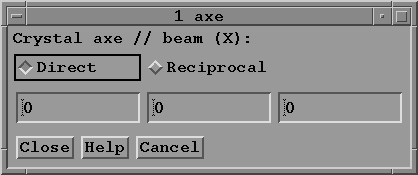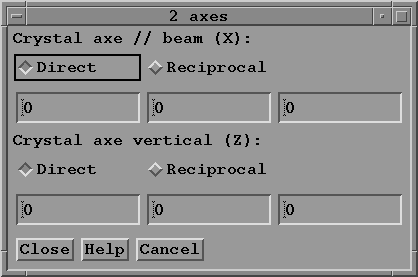The "Orientation" pulldown menu:
This button is used to indicate to the program the orientation of the
crystal to compute a simulation. The orientation
may be given either as:
1 axis:
The choice of this option directs you to the following menu:

Give the indexes of the crystallographic direction
pointing towards the X-ray source. This
direction may be a direction in the direct space if you
activate the "Direct" button or a direction in the reciprocal space
when activating the "Reciprocal" button.
2 axes:
Using this option, you completely define the
orientation of the crystal. It directs you to the following menu:

Give the indexes of the crystallographic direction
pointing towards the X-ray source, and thoses of the
crystallographic direction along the vertical OZ axis.
These directions may be directions in the direct space or in the
reciprocal space, depending on the state of the "Direct" button
or the "Reciprocal" button.
This button is used when
the orientation of the crystal is already known (previously given
by the user or as the result of an indexation procedure),
and the user wishes to apply one or more rotations
to the crystal.
Warning: the rotations are always given with
reference to the initial position of the crystal.
It displays the following menu:

The numbers on the left enable you to choose which rotation
is applied first, second and third.
Give the values of the angles (in degrees) by
scrolling the cursors.
According to the characteristics of the goniometer
you activate or not the "Dependant rotations" button.
Apply theses rotations by clicking on the
"Apply" button.
You may then compute the new simulation.
This button is used when
the orientation of the crystal is known (previously given
by the user or as the result of an indexation procedure),
and the user wishes to align a crystal direction
with an axis of the apparatus set of axes.
The following menu is displayed:

First it is necessary to give the indexes of the
cristallographic direction to be aligned. This direction may
be a direction in the direct
space if the "Direct" button is selected
or a direction in the reciprocal space
if the "Reciprocal" button is selected.
Then select the axis along which you wants to
align the cristallographic direction.
According to the characteristics of the goniometer
choose dependant or independant rotations.
Finally, press the "Compute possible rotations" button;
the program suggest four possible solutions. Choose one of
them by clicking the corresponding box. Tou may then compute a new
simulation.



